中考英语课件英语阅读教学设计(共54张PPT)
文档属性
| 名称 | 中考英语课件英语阅读教学设计(共54张PPT) |  | |
| 格式 | pptx | ||
| 文件大小 | 706.0KB | ||
| 资源类型 | 教案 | ||
| 版本资源 | 通用版 | ||
| 科目 | 英语 | ||
| 更新时间 | 2022-05-03 23:15:04 | ||
图片预览


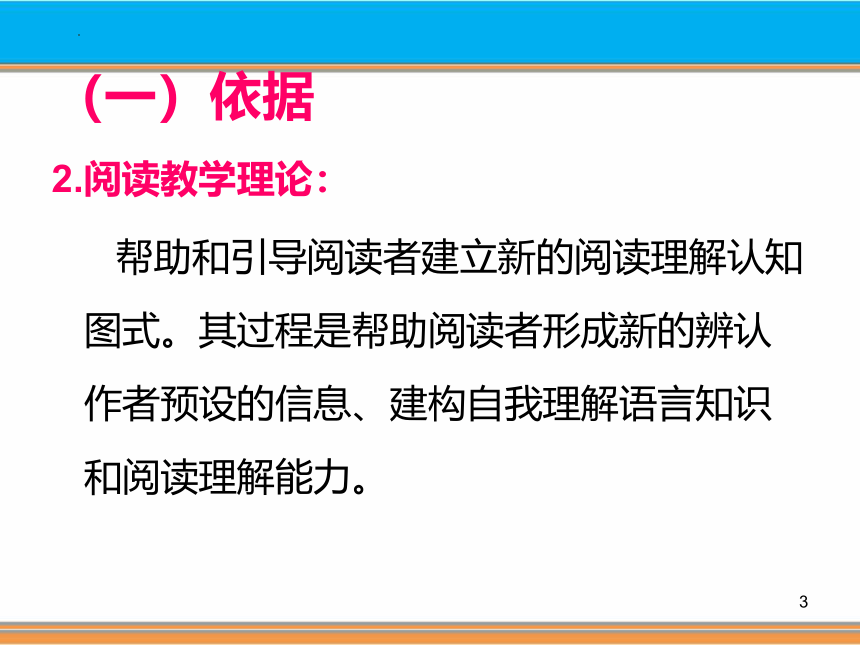
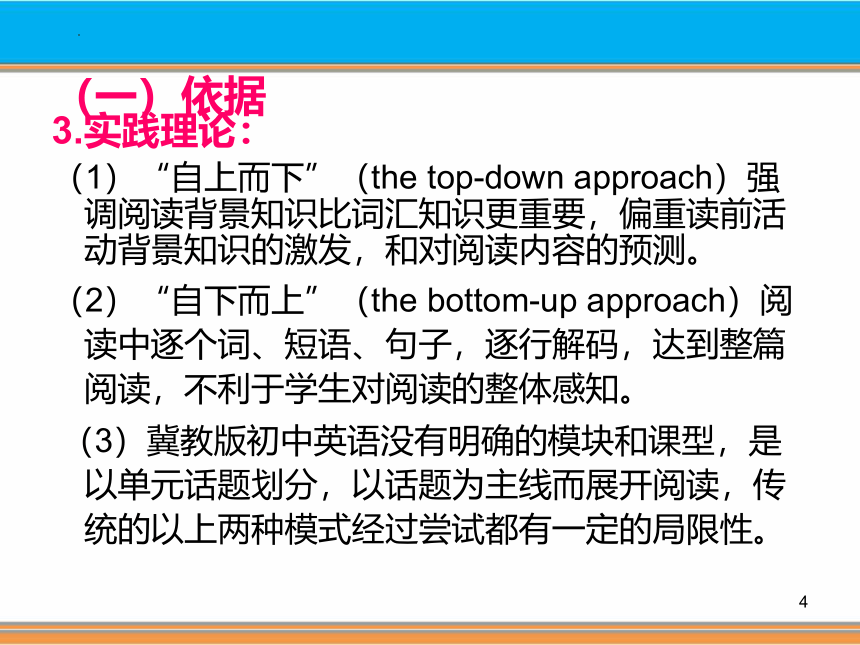

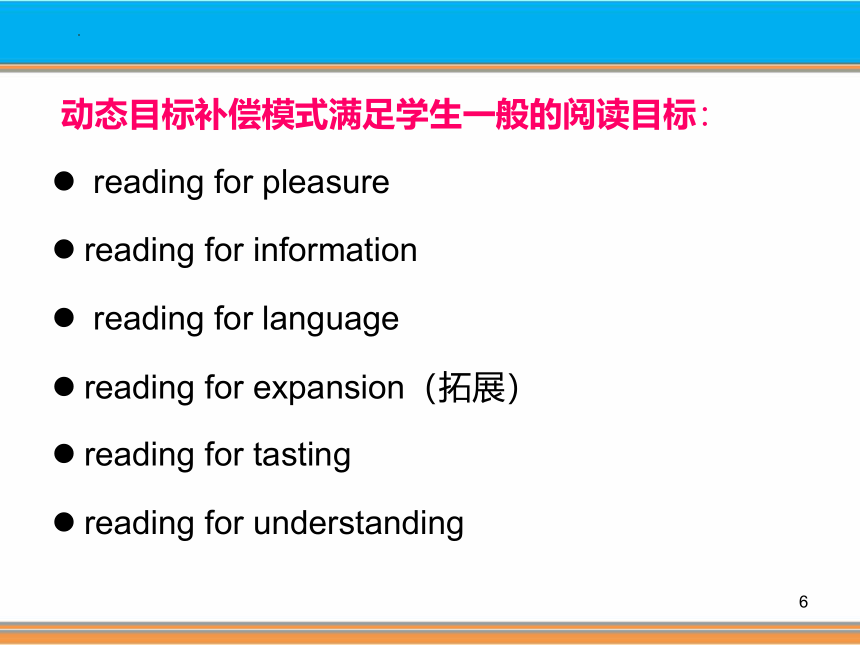
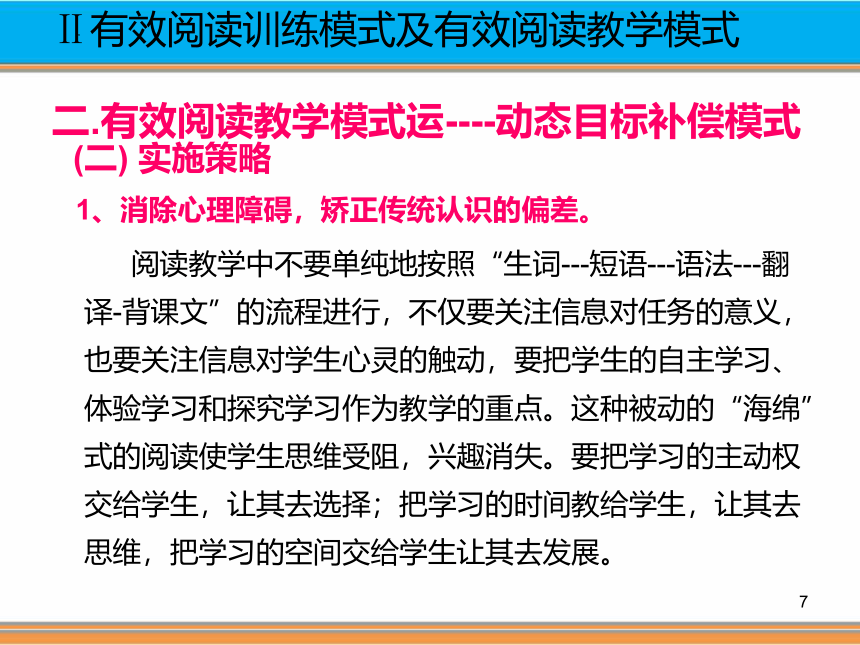

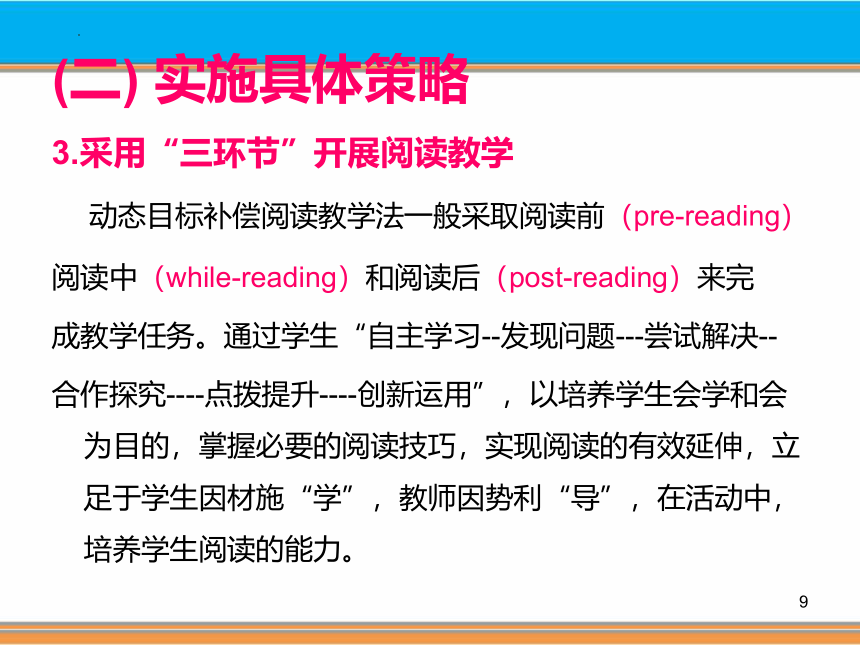
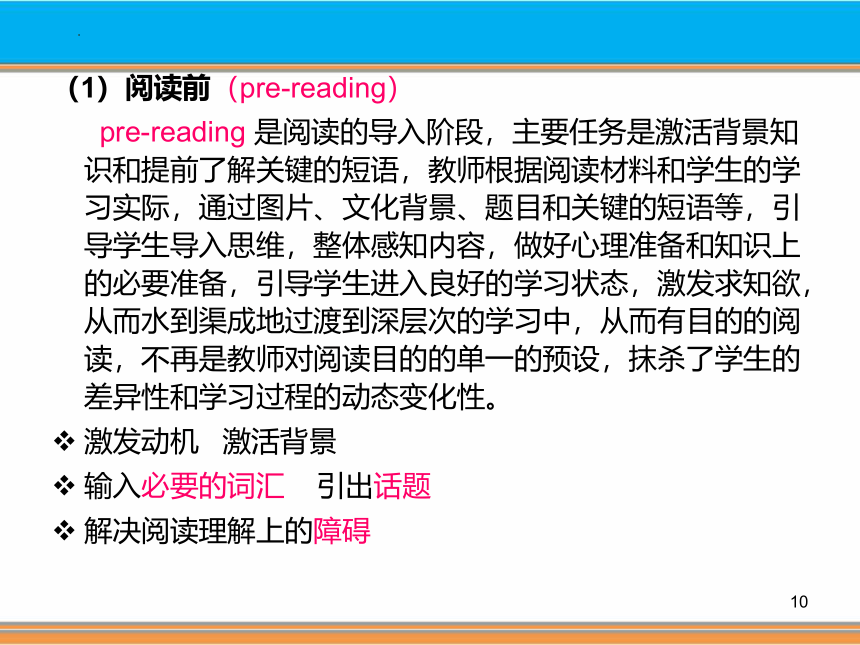
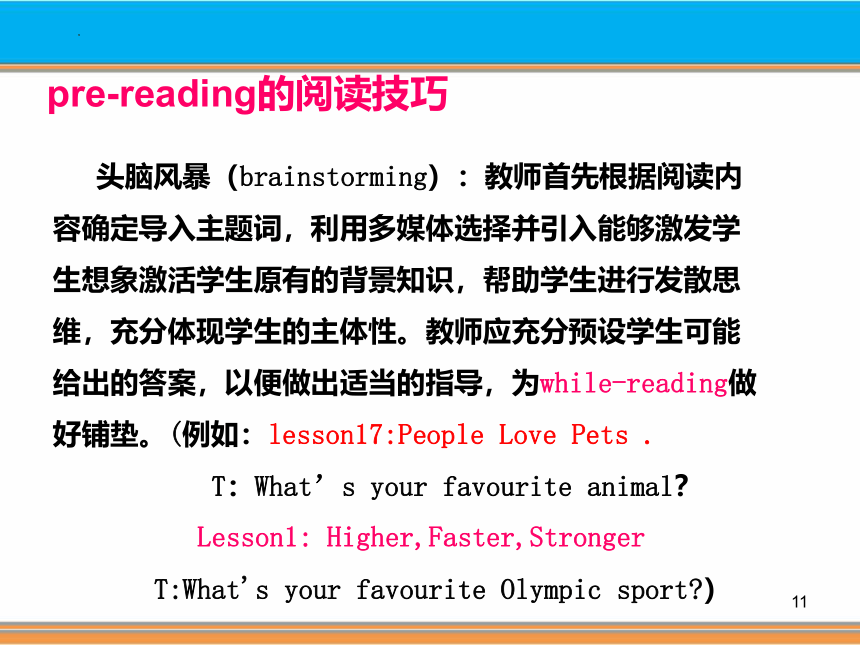
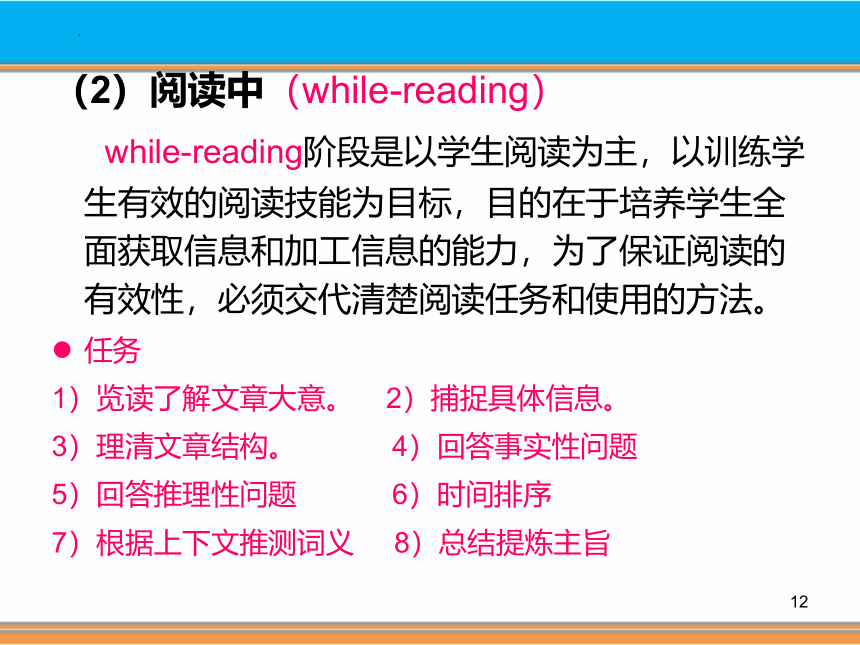
文档简介
(共54张PPT)
1
英语阅读教学设计
2
有效阅读教学模式运用---动态目标补偿模式
(一)依据:
1.建构主义理论:强调以学生为中心,成为信息加工的主体,知识意义的主要建构者。建构主义理论认为学习不是被动接受信息刺激,而是主动的建构意义,以自己原有的经验为基础,对新内容重新认识和编码,获得意义,形成自己的见解。
3
(一)依据
2.阅读教学理论:
帮助和引导阅读者建立新的阅读理解认知图式。其过程是帮助阅读者形成新的辨认作者预设的信息、建构自我理解语言知识和阅读理解能力。
4
(一)依据
3.实践理论:
(1)“自上而下”(the top-down approach)强调阅读背景知识比词汇知识更重要,偏重读前活动背景知识的激发,和对阅读内容的预测。
(2)“自下而上”(the bottom-up approach)阅读中逐个词、短语、句子,逐行解码,达到整篇阅读,不利于学生对阅读的整体感知。
(3)冀教版初中英语没有明确的模块和课型,是以单元话题划分,以话题为主线而展开阅读,传统的以上两种模式经过尝试都有一定的局限性。
5
有效阅读模式的建构
交互作用的模式是结合以上两种模式,同时在尊重阅读内容基础上,更尊重学生的差异性和学习的主体性,尊重阅读过程的动态变化。既强调背景知识,上下文预测的重要性,又不忽视单词的解码,迅速捕捉关键信息来理解阅读材料的重要性,反映阅读过程本质。
6
动态目标补偿模式满足学生一般的阅读目标:
reading for pleasure
reading for information
reading for language
reading for expansion(拓展)
reading for tasting
reading for understanding
7
Ⅱ有效阅读训练模式及有效阅读教学模式
二.有效阅读教学模式运----动态目标补偿模式
(二) 实施策略
1、消除心理障碍,矫正传统认识的偏差。
阅读教学中不要单纯地按照“生词---短语---语法---翻译-背课文”的流程进行,不仅要关注信息对任务的意义,也要关注信息对学生心灵的触动,要把学生的自主学习、体验学习和探究学习作为教学的重点。这种被动的“海绵”式的阅读使学生思维受阻,兴趣消失。要把学习的主动权交给学生,让其去选择;把学习的时间教给学生,让其去思维,把学习的空间交给学生让其去发展。
8
(二) 实施策略
2.加强阅读方法指导,培养良好的阅读习惯
在交互作用的模式教学中,教师根据阅读内容和学生实
际,通过课前预习、背景和词汇的适当输入,设置问题、限
时限量阅读、互动讨论、小组探究等途径,引导学生思维、
思考、想象、理解,挖掘作者的深层次的编写意图,将课
堂引向“目标--活动--探究--领悟---创造”的学习模式中。指导学生在阅读过程中做些批注、划出记号,挖出信息点。
多用what、where、when、how、why等提问,改变学生逐
词、逐句回读、指着读、出声读,一遇到单词就查字典的不
良习惯。
9
(二) 实施具体策略
3.采用“三环节”开展阅读教学
动态目标补偿阅读教学法一般采取阅读前(pre-reading)
阅读中(while-reading)和阅读后(post-reading)来完
成教学任务。通过学生“自主学习--发现问题---尝试解决--
合作探究----点拨提升----创新运用”,以培养学生会学和会为目的,掌握必要的阅读技巧,实现阅读的有效延伸,立足于学生因材施“学”,教师因势利“导”,在活动中,培养学生阅读的能力。
10
(1)阅读前(pre-reading)
pre-reading 是阅读的导入阶段,主要任务是激活背景知识和提前了解关键的短语,教师根据阅读材料和学生的学习实际,通过图片、文化背景、题目和关键的短语等,引导学生导入思维,整体感知内容,做好心理准备和知识上的必要准备,引导学生进入良好的学习状态,激发求知欲,从而水到渠成地过渡到深层次的学习中,从而有目的的阅读,不再是教师对阅读目的的单一的预设,抹杀了学生的差异性和学习过程的动态变化性。
激发动机 激活背景
输入必要的词汇 引出话题
解决阅读理解上的障碍
11
pre-reading的阅读技巧
头脑风暴(brainstorming):教师首先根据阅读内容确定导入主题词,利用多媒体选择并引入能够激发学生想象激活学生原有的背景知识,帮助学生进行发散思维,充分体现学生的主体性。教师应充分预设学生可能给出的答案,以便做出适当的指导,为while-reading做好铺垫。(例如:lesson17:People Love Pets .
T:What’s your favourite animal?
Lesson1: Higher,Faster,Stronger
T:What's your favourite Olympic sport )
12
(2)阅读中(while-reading)
while-reading阶段是以学生阅读为主,以训练学生有效的阅读技能为目标,目的在于培养学生全面获取信息和加工信息的能力,为了保证阅读的有效性,必须交代清楚阅读任务和使用的方法。
任务
1)览读了解文章大意。 2)捕捉具体信息。
3)理清文章结构。 4)回答事实性问题
5)回答推理性问题 6)时间排序
7)根据上下文推测词义 8)总结提炼主旨
13
while-reading常用的阅读策略:
skimming粗读
这一步骤是为掌握文章大意而进行的阅读,要求学生
读后找出文章的大意(general idea)、主题句(topic sentence),概括文章的标题(title),并注意文
章的关键词、过渡词等。也可以设计一些简单的选择题或者
判断对错的问题给学生回答。此环节要提醒学生不要逐词逐
句的看课文,要讲究速度,在最短时间内找到问题的答案。
在环节中,教师可向学生展示下列问题:
1 What is the main idea of the text
2 What is the topic sentence of each paragraph
14
平时教学做到“七引导”:
(1)引导学生找出所读材料的主题段;
(2)引导学生指出某一小节的主题句;
(3)引导学生找出某一小节的关键词;
(4)引导学生用关键词概括所读的内容;
(5)引导学生抓住主要问题,概括所读的内容;
(6)引导学生抓住所学文章中的时间和空间顺序;
(7)引导学生抓住文章的主要逻辑线索等。
15
Scanning (跳读)
这是一种为寻求特定细节,放弃大部分无关内容,只注意某一点或几点的阅读方式。要求学生根据老师准备的几个信息问题抓住重点进行跳跃式阅读,找出问题的主要信息。这些问题一般围绕:when, where, what, why, who等w问题。如年代、数字、人名、地名等把握住关键词, 利用语法过渡词,语气转折词及时态等,抓住文章脉络。通过此环节培养学生的阅读速度,和敏捷的阅读思维。
16
Intensive reading (细读)
仔细阅读,掌握全文内容及语言特征和具体细节等。要求学生明确文章结构,找出语法难点,学习重点词语,进一步吸收新的词语知识、语法知识和文化知识。教师可以在读后让学生自己提出问题,包括不明白的单词,短语,句子结构,语法等。
在阅读课中,知识点和语法的讲解要尽量简练,因为阅读课的目的主要培养的是学生的阅读技能。
17
Inferring reading(推读)
推测未直接写明的含义、因果关系,引导学生学会根据上下文进行猜测,既提高阅读速度又形成了一种能力,这也是英语阅读的关键所在。培养学生使用工具书的能力,提高学生自学能力,通过推理、判断、归纳等活动,激活思维有效延伸知识建构。
18
Listening and reading (听读)
在操作完细读后可以让学生听课文录音,教师要告诉学生听的时候注意语音、语调,并尽量模仿,然后让学生大声朗读。这一步骤可以训练学生的听力,帮助学生进一步理解课文,为下一步复述课文打下基础。一开始可以看着书本听,熟悉课文后也可以合上书本听。
19
1.正确地组块: 组块阅读按照意义建构,要求学生尽可能把句子分成意义完整的组群,帮助学生克服逐词读,用手指着读。试比较:
(1)Read/the/words/one/by/one.(目光停顿6次)
(2)Read the words/one by one.(目光停2次)
组块阅读的关键在于它既不是默读(心读),更不是朗读,而是通过目光在文字与大脑之间建立直接的联系,形成英语思维,克服生词卡壳的坏习惯,这是一个简捷快速的过程,需要经过大量阅读训练才能实现。所谓的“一目十行”。
阅读中颇为有效的策略
20
请看下面这段话:
Four weeks ago I was late for work.I left my house five minutes later than usual, and I saw my bus coming toward the bus stop. I began to run, but I was too slow. I waited ten minutes for another bus.
21
请看下面这段话:
Four weeks ago/I was late for work./I left my house/five minutes later than usual,/and I saw /my bus coming/toward the bus stop. /I began to run,/but I was too slow./I waited ten minutes/for another bus.
组块阅读是一种非常好的阅读方法,既提高了速度,又有助于理解。
22
2.正确“断点”
基本原则:把主句和从句断开,把主干部分和修饰部分断开。
2.以连词为断开点。如and、but、so、yet、for、while、or、nor等并列连词连接着并列句,还有连接从句的从属连接词,如that、which、when、where、who、as、since、until、before、after 、because、since、although、so that等等,它们就成了理解英语句子的断开点。
3.以介词为断开点。如on、in、with、at、of、 to等介词常常引导介词短语 作修饰语,它们也是理解英语句子的断开点。
23
4. 以不定式符号to为断开点。不定式常常构成不定式短语做定语或者状语修饰语,所以也可以是断开点。
5.以分词为断开点。过去分词和现在分词可以构成分词短语作修饰语,所以可以是断开点。
6.以标点符号为断开点。标点符号常常断开句子的主干和修饰部分,也是一个明显的断开点。
24
(3)post-reading(阅读后)
post-reading是阅读后的拓展部分。本阶段有两大目的
一是根据阅读内容进行各种思维活动;二是鼓励学生将所学
的内容与自己生活经历、知识、兴趣和观点联系起来。具体
包括:
根据文章回答问题
判断正误(T/F)
翻译句子
句子排序
回填或补句子
复述或缩写
填写调查报告
25
分角色表演对话
根据阅读内容拓展,写短文
找出文章的main idea、key sentences或title
材料外的信息与材料连线
基于课文的采访
价值观念、情感回归。(冀教版下unit8 Save our
World(stop pollution )为了深化主题、培养学生积极情感
和正确的价值观,播放了一段视频《earth song》,并给出
一个话题:How can we protect our earth?
26
阅读教学过程
读前活动
读中活动
读后活动
激活背景知识
处理生词
掌握主旨大意
了解细节
巩固阅读内容
(读说结合,
读写结合)
策略教学
人文素养培养
27
案例分析1
Unit 7 Would you mind keeping your voice down
(一)、 Pre-read (目的在于熟悉话题,预测内容,激发学生的兴趣和愿望,
激活相关语言)
1.背景涉入:
What does etiquette mean
Look at the picture on P58.
How many rules of etiquette can you see being broken
(你能看到多少条礼节规则被破坏了?) Make a list with your partner.
e.g: Don’t talk loudly in public.
2.关键词汇:
(听录音,注意语音语调,突出重点词语。)
单词/ 短语:
at first in public
扑灭 咳嗽 亚洲的 批评
28
(二)、while-reading
1、Read quickly and find out the topic sentences.
(快速阅读,了解大意,掌握阅读策略,跳读,掌握基本信息)
True or false
1)Etiquette is a normal and impolite social behavior.
2)Etiquette is the same in every culture or in every situation.
3)Standing very close to the person you are talking with is common in European countries.
4)Etiquette is the same in all situations in China.
5)Talking loudly in a library is impolite.
6)We should take care not to cough or sneeze loudly in public.
7) Dropping litter in other countries is allowed.
29
2、Read more carefully and answer:
(分段细读,深挖阅读材料,掌握重点句型、语法,找出段落中心句)
Paragraph 2 Read and fill in the blanks:
Etiquette is not the _______in every _______(文化)or in every ________. _____ ______(例如), _____ very close to the person you are talking with is quite ________ in some _________countries. ________, in _____ if you do this, some people might feel _________. In China, etiquette is not the same in all situations.______ loudly in our own homes is fine, but talking ______ in a l______, a museum ,or a movie theater is __________. Even if you are with your friends, it is better to _______ your ______ _______ in _______ places. In fact, we should also take care not to ________ or ________ loudly __.
30
三、post-reading
综合训练
1、 ______ means ______and ______ _____ _______.
(礼节是指正式的有礼貌的社会行为。)
2、 _____ ( drop) litter is almost never _______(被允许)..
3、 If we see someone ________ ______ _______ ______
______( 违反了礼仪规则), we may _____ (礼貌) give them some
_______.(建议)
4、 或许最有礼貌的的方式之一是问某人.
5、Although rules of etiquette can often be different, some rules
are the same almost everywhere in the world.
6 、 讨论强化(根据生活实际,展开讨论,也可组织辩论赛)
7、 拓展应用(复述故事或分角色表演等)
31
阅读教学案例2
China’s First Gold in Swimming(Lesson 2, Unit 1, Book 5)(原文)
Zhuang Yong swam her way to a gold medal today. It was the first gold medal in an Olympic swimming event for our country. Zhuang Yong won the women’s 100-meter freestyle with a time of 54.64 seconds.
It was a very close race. When it was over, no one knew who had won. It seemed that Zhuang Yong and Jenny Thompson, an American swimmer, had finished at the same time. When it showed: “First, Zhuang Yong, China. Second, Jenny Thompson, U.S.A.”, the Chinese spectators at the swimming pool jumped up and down, cheering. They were very excited!
Zhuang Yong surprised everyone. Before the Olympics, her best time had been slower than Miss Thompson’s. Miss Thompson had set a world record in the 100-meter event, with a time of 54.48 seconds. But today Zhuang Yong caught up with the American swimmer. She also won two silver medals. Zhuang Yong began swimming when she was eight years old. She is one of the four Chinese women to win Olympic medals in swimming at the 1992 Olympic Games. The otheres are Qian Hong, Lin Li and Yang Wenyi.
32
Pre-reading
Step 1: Lead in
Project a picture about a swimming event
Thinking or discussing:
Are you interested in sports
What sports do you like best
What sports are you good at
Have you ever gone swimming
Where do you like to swim
Have you watched Olympic Games on TV
Who is your sports star
33
Step 2: Listening and speaking
Pre-listening (to deal with two new words): Have you heard of Zhuang Yong, Qian Hong They are all swimmers. They are best at swimming. They are good at freestyle(with body language). Have you heard of Luo Xuejuan She is also a very good swimmer. She is a good frog style swimmer.
Listening
Post-listening tasks:
1. When did Zhuang Yong begin swimming (8)
2. When did Zhuang Yong win the gold medal (92)
34
while-reading:
Step 3: Skimming (Reading)
Pre-reading tasks: Read the passage in 2 minutes and try to tell us the main idea of the passage in one or two sentences.
Skimming
Post skimming:
Individual or pair work(Discussing in pairs): try to sum up the passage.
“Zhuang Yong surprised us at the 1992 Olympic Games. She won the first gold medal in swimming for China.”
35
Step 4: Scanning (maybe one or two times) (for some special information)
Pre-scanning tasks:
1. How long did Zhuang Yong spend in the 100-
meter freestyle (54.64 seconds)
2. Who was the second winner (Jenny Thompson)
Scanning
Post Scanning: Ss write the right answers and then
exchange paper with their partners.
36
Step 5: Reading(for details) and speaking
1. What did the Chinese spectators at the swimming
pool do Why
2. What record had Miss Thompson set
3. Who were the other three swimmers winning
the gold medals at Barcelona in 1992
Self-reading
Post-reading:
1. Ss discuss with their partners.
37
post-reading:
1. Two or three Ss try to retell the story or Ss try to retell
in groups.
2. Project: (Group work) Complete the table
(about sports stars)
3. Write a short story about a game or one of your sports stars.
38
Ⅲ、中考对阅读理解的考查及 思路破解
1、试题设置:中考对阅读水平的考察分了四种大题型:完型填空、阅读理解、短文填空和任务型阅读。
每个语篇字数在200-280之间,生词率不超过3%,并且作出标注,选材丰富,体裁各异,富有时代特征。
(一)阅读的考查定位:
39
1、自读之前启发讲:即在学生自主阅读之前,简明扼要地揭示阅读背景。
2、重点地方着重讲:对材料中的重点、难点和关键之处,在学生自读、自悟的基础上进行重点讲解,该挖掘处必挖掘,该品味,该讲深讲透的地方必须讲深讲透。
3、疑难问题明确讲:当学生在材料理解上遇到疑难时教师要鲜明地讲, 从而为学生解难释疑,让学生正确理解、领悟材料内容。
4、合作中提示讲:当学生在合作学习中不能抓住要点进行有效合作时,教师要进行提示性讲解,以使合作有效、深入。
5、总结时补充讲:在总结一节课、一篇材料的阅读情况时,在学生概括、总结的基础上,教师要及时进行补充,以进一步进行提炼和归纳。
4、阅读教学中教师该讲什么?
40
(一)阅读的考查定位:
2、考查角度:细节、推断(题目、生词)、主旨大意等(不再考查常识性试题)
41
1) 细节
旨在考查:快速阅读能力和快速获取和筛选信息的能力。
近年各市英语试卷中均有一定量的细节题作为考查的基础题。文章的中心思想往往由细节来表达或支撑,弄清细节、认定事实是阅读理解的最基本要求。细节性考查主要贯穿在一些记叙性段落中,是对特定的环节设置的问题,要求学生在十分有限的时间内运用略读和跳读等技巧快速阅读,搜寻关键词、主题句,捕捉时空、顺序、情节、人物、观点,并且理清文章脉络,把握语篇实质。
42
2) 推理判断能力
旨在考查学生的逻辑思维和想象思维能力,评估学生常态化阅读技巧的运用能力。
标题、态度推理。 主要考查学生对比较抽象的概念的理解,对全篇逻辑管理的理解,“言外之意”的深刻理解和实质的判断,并据此进行推理和判断的能力。
为了加强初中阶段的阅读教学,使学生尽快适应升入高一级学校后新的英语学习要求,各市均把对语篇理解和推理判断能力的测试作为近年阅读理解考查的重点,要求考生能对文字的表面信息进行分析和挖掘,研究细节的暗示,推敲作者的态度,通过合乎逻辑的推理而理解文章的寓义。这种深层理解的思维活动,必须以文章提供的事实和线索为依据,立足已知推断未知,而不能凭空想象、随意揣测、就事论事、以偏概全。
43
词汇推理
以语篇为单位的阅读有赖于词汇作支撑,阅读能力的提高离不开词汇的积累和对词义的正确理解,同时根据上下文推测生词的词义也是一项重要的阅读能力。它不但需要学生能准确无误地理解上下文,还要通过较大量的泛读掌握或认识较多的课外词汇。
要求考生能通过构词、语法、定义、同位、对比、因果、常识、上下文等线索确定词义。有的除猜测字面意思外,还提高到对单词引申意义的考查。这既是对学生阅读理解能力一个方面的有效检测,也将能起到引导学生活学活用单词、抛弃死记硬背记忆方法的作用。
44
3) 主旨大意
主旨大意是文章的核心, 是对全文的概括与总结。阅读理解首先就是对文章主旨大意的理解。能否抓住这个中心,体现了学生总结、概括和归纳事物的能力。
中心思想贯穿于全文,必须在通读全文的基础上,经过归纳、分析才能知道作者的基本观点和概括出文章的中心思想。考生要能较好地掌握主旨大意,就必须要有很强的篇章概括能力、分清主要信息和次要信息的能力和准确把握篇章段落的主旨大意的能力。多数试卷注意引导考生采用按照意群阅读、跳读和略读等阅读方法,快速理解文章主旨大意,并在文章中搜索正确答案。
45
(二)有效破解
【完形填空】
此题通过阅读考查学生语言知识的综合运用能力。注重对学生语篇整体理解能力的考查。要求学生不仅要具有一定的词汇和语法知识,在句子层次上来考虑单词搭配、惯用语和语法等,而且还要具备一定的阅读能力、综合分析能力和综合运用语言知识的能力。
速读全文 了解主题 运用多种阅读技能,快速浏览阅读材料,掌握大意,选出固定搭配。
兼顾语法 找准关联
找出关联词,顺藤摸瓜,逐层破解。
通读验证 修复完整
把选定的答案带入原文仔细阅读,上下推敲。
46
完型:Jenny, from Germany, spent some time traveling in India. While she was there, she stayed with her Indian friend, Leela. However, there was a language barrier(障碍) for her there. It was very 31 for her to communicate in the new environment, which was very different from 32 of her own country.
One day, together with Leela, Jenny went to 33 an orphanage(孤儿院). All the children there were very young. At first, Jenny was not sure if she could have a way to communicate with them. She went over to the children 34 and sat beside them. After some time, one of the children 35 her. She felt a little relaxed and smiled back. Then she went close to the child. She slowly put her arm around the child and started 36 a song in German. The child kept smiling and started repeating the words after her. The words that came from the little mouth were different from those that Jenny sang, but the rhythm(节奏) was the same. Jenny sat a little more and the child followed her again. Wanting to join in the 37 , another child went up to Jenny and started singing the rhythm. Then more children joined. They 38 many smiles together.
From the other side of the hall, Leela was smiling and watching them. Noticing Leela’s 39 on her, Jenny had an exciting feeling from her heart: “See, I don’t have any language barriers here. We 40 speak and communicate!” At that moment, she understood: we’re all simple human, and we have the ability to connect with each other.
47
31. A. nice B. dangerous C. difficult D. easy
32. A. these B. those C. this D. that
33. A. show B. visit C. build D. improve
34. A. slowly B. early C. hardly D. easily
35. A. looked at B. laughed at C. shouted at D. smiled at
36. A. singing B. writing C. saying D. playing
37. A. club B. talk C. fun D. dance
38. A. forgot B. remembered C. shared D. missed
39. A. hands B. eyes C. influence D. question
40. A. can B. must C. need D. should
48
阅读理解
此题主要考查学生的语篇阅读能力以及分析和判断能力。本题四篇阅读材料,试题的设计以考查学生获取信息、处理信息的能力以及分析问题、解决问题的能力为主。生词率不超过3%。阅读理解题是中考英语的测试重点,也是中考英语试题中卷面分值最高的一种题型。
一般设四篇短文,试题采用“根据所给阅读材料判断正误”或“选择最佳答案”两种形式。
观近年来全国各地中考阅读题,其体裁多样,有记叙文、议论文、说明文、应用文(信函、请柬、通知、便条、表格、图表、广告、图示和标志等);所选材料内容广泛,涉及文化、环境、科普、社会、政治、经济、历史等众多领域。文章的体裁富于变化,可谓题材宽泛,形式多种多样。
其特点是:时气息浓,可读性强,理解难度较高。
49
【任务阅读】
弄清任务---遵循顺序---粗读挖点----细读分析
做此类题时,首先要浏览一下问题,然后带着这些问题通读课文,并在原文中找出与每个问题相关的段落或词句。用这种方法可以节省阅读时间,以便有充足时间进行核查。
【短文填空】
粗读单词---激活运用---- 带缺速读-----猜出用途
-----时态变形----回读敲定。
50
Hawaii has always been a magic name to people who like traveling. People from all over the world dream of seeing the beautiful islands in the middle of the ocean. It’s always one of their dreams to watch the sun going down. The sun drops like a ball of bright fire into the sea, and it drops so quickly that you can even see it move.
About two thousand years ago, the first people went to Hawaii in a very small boat. They found the beautiful white sand beaches and the waving palm trees. But it was difficult for people to go to Hawaii at that time. And there were no big hotels like the ones today. Now people can get to Hawaii in different ways. More and more people go to Hawaii. So lots of nice big hotels have been built in recent years. However, the scenery(自然风景) in Hawaii hasn’t changed much. The white sand beaches and the waving palm trees are still there. People often have a peaceful time, taking a walk along the water in the morning. At night, they get together to hold parties, chatting and dancing. So if you’re thinking about relaxing yourself, Hawaii is surely the first place for you to choose.
41.The sun in Hawaii drops too quickly for people to see it move.
42.In Hawaii, a large number of nice big hotels have been built in recent years.
43. The scenery in Hawaii is quite different from what it was many years ago.
44. According to the passage, it’s common for people to hold parties in Hawaii at night.
45. The passage mainly tells us the first people who came to Hawaii.
51
判断(T/F)
做这类题时,可以使用对照法,即将原文中与题干意思相近的句子或段落找出来,与题干一一对照,详细区分,切不可片面理解,更不可想当然。对于简单明了的文章,要注意其首尾句以及表明文章主旨的中心句、关键语等。对读了一遍意思还不够明了的文章,我们除了要了解全文,弄清人物、时间、地点、时间、原因等要点外,还要仔细推敲复杂的句子,弄清句子及全文的意思。
【阅读理解】
52
【阅读理解】
单选
逆向思维
从文章题目的设置入手,带着问题有的放矢地阅读。尽快理解大意、捕捉信息,有助于解题。逆向阅读首先要掌握问题的类型,分清是客观信息题还是主观判断题:客观信息题通常能直接从文中找到答案;主观判断题考查的是作者在文章中陈述的观点以及贯穿全文的中心主旨的理解等,这类题必须经过对作者的态度、意图以及对整篇文章进行深层推理后才能得出。
首尾句分析
尤其是对题目或段落含义等具体考查时,学生一定要仔细分析首尾的内在含义和提纲挈领关系。
53
提问与解答环节
Questions and answers
54
谢谢您的观看与聆听
Thank you for watching and listening
1
英语阅读教学设计
2
有效阅读教学模式运用---动态目标补偿模式
(一)依据:
1.建构主义理论:强调以学生为中心,成为信息加工的主体,知识意义的主要建构者。建构主义理论认为学习不是被动接受信息刺激,而是主动的建构意义,以自己原有的经验为基础,对新内容重新认识和编码,获得意义,形成自己的见解。
3
(一)依据
2.阅读教学理论:
帮助和引导阅读者建立新的阅读理解认知图式。其过程是帮助阅读者形成新的辨认作者预设的信息、建构自我理解语言知识和阅读理解能力。
4
(一)依据
3.实践理论:
(1)“自上而下”(the top-down approach)强调阅读背景知识比词汇知识更重要,偏重读前活动背景知识的激发,和对阅读内容的预测。
(2)“自下而上”(the bottom-up approach)阅读中逐个词、短语、句子,逐行解码,达到整篇阅读,不利于学生对阅读的整体感知。
(3)冀教版初中英语没有明确的模块和课型,是以单元话题划分,以话题为主线而展开阅读,传统的以上两种模式经过尝试都有一定的局限性。
5
有效阅读模式的建构
交互作用的模式是结合以上两种模式,同时在尊重阅读内容基础上,更尊重学生的差异性和学习的主体性,尊重阅读过程的动态变化。既强调背景知识,上下文预测的重要性,又不忽视单词的解码,迅速捕捉关键信息来理解阅读材料的重要性,反映阅读过程本质。
6
动态目标补偿模式满足学生一般的阅读目标:
reading for pleasure
reading for information
reading for language
reading for expansion(拓展)
reading for tasting
reading for understanding
7
Ⅱ有效阅读训练模式及有效阅读教学模式
二.有效阅读教学模式运----动态目标补偿模式
(二) 实施策略
1、消除心理障碍,矫正传统认识的偏差。
阅读教学中不要单纯地按照“生词---短语---语法---翻译-背课文”的流程进行,不仅要关注信息对任务的意义,也要关注信息对学生心灵的触动,要把学生的自主学习、体验学习和探究学习作为教学的重点。这种被动的“海绵”式的阅读使学生思维受阻,兴趣消失。要把学习的主动权交给学生,让其去选择;把学习的时间教给学生,让其去思维,把学习的空间交给学生让其去发展。
8
(二) 实施策略
2.加强阅读方法指导,培养良好的阅读习惯
在交互作用的模式教学中,教师根据阅读内容和学生实
际,通过课前预习、背景和词汇的适当输入,设置问题、限
时限量阅读、互动讨论、小组探究等途径,引导学生思维、
思考、想象、理解,挖掘作者的深层次的编写意图,将课
堂引向“目标--活动--探究--领悟---创造”的学习模式中。指导学生在阅读过程中做些批注、划出记号,挖出信息点。
多用what、where、when、how、why等提问,改变学生逐
词、逐句回读、指着读、出声读,一遇到单词就查字典的不
良习惯。
9
(二) 实施具体策略
3.采用“三环节”开展阅读教学
动态目标补偿阅读教学法一般采取阅读前(pre-reading)
阅读中(while-reading)和阅读后(post-reading)来完
成教学任务。通过学生“自主学习--发现问题---尝试解决--
合作探究----点拨提升----创新运用”,以培养学生会学和会为目的,掌握必要的阅读技巧,实现阅读的有效延伸,立足于学生因材施“学”,教师因势利“导”,在活动中,培养学生阅读的能力。
10
(1)阅读前(pre-reading)
pre-reading 是阅读的导入阶段,主要任务是激活背景知识和提前了解关键的短语,教师根据阅读材料和学生的学习实际,通过图片、文化背景、题目和关键的短语等,引导学生导入思维,整体感知内容,做好心理准备和知识上的必要准备,引导学生进入良好的学习状态,激发求知欲,从而水到渠成地过渡到深层次的学习中,从而有目的的阅读,不再是教师对阅读目的的单一的预设,抹杀了学生的差异性和学习过程的动态变化性。
激发动机 激活背景
输入必要的词汇 引出话题
解决阅读理解上的障碍
11
pre-reading的阅读技巧
头脑风暴(brainstorming):教师首先根据阅读内容确定导入主题词,利用多媒体选择并引入能够激发学生想象激活学生原有的背景知识,帮助学生进行发散思维,充分体现学生的主体性。教师应充分预设学生可能给出的答案,以便做出适当的指导,为while-reading做好铺垫。(例如:lesson17:People Love Pets .
T:What’s your favourite animal?
Lesson1: Higher,Faster,Stronger
T:What's your favourite Olympic sport )
12
(2)阅读中(while-reading)
while-reading阶段是以学生阅读为主,以训练学生有效的阅读技能为目标,目的在于培养学生全面获取信息和加工信息的能力,为了保证阅读的有效性,必须交代清楚阅读任务和使用的方法。
任务
1)览读了解文章大意。 2)捕捉具体信息。
3)理清文章结构。 4)回答事实性问题
5)回答推理性问题 6)时间排序
7)根据上下文推测词义 8)总结提炼主旨
13
while-reading常用的阅读策略:
skimming粗读
这一步骤是为掌握文章大意而进行的阅读,要求学生
读后找出文章的大意(general idea)、主题句(topic sentence),概括文章的标题(title),并注意文
章的关键词、过渡词等。也可以设计一些简单的选择题或者
判断对错的问题给学生回答。此环节要提醒学生不要逐词逐
句的看课文,要讲究速度,在最短时间内找到问题的答案。
在环节中,教师可向学生展示下列问题:
1 What is the main idea of the text
2 What is the topic sentence of each paragraph
14
平时教学做到“七引导”:
(1)引导学生找出所读材料的主题段;
(2)引导学生指出某一小节的主题句;
(3)引导学生找出某一小节的关键词;
(4)引导学生用关键词概括所读的内容;
(5)引导学生抓住主要问题,概括所读的内容;
(6)引导学生抓住所学文章中的时间和空间顺序;
(7)引导学生抓住文章的主要逻辑线索等。
15
Scanning (跳读)
这是一种为寻求特定细节,放弃大部分无关内容,只注意某一点或几点的阅读方式。要求学生根据老师准备的几个信息问题抓住重点进行跳跃式阅读,找出问题的主要信息。这些问题一般围绕:when, where, what, why, who等w问题。如年代、数字、人名、地名等把握住关键词, 利用语法过渡词,语气转折词及时态等,抓住文章脉络。通过此环节培养学生的阅读速度,和敏捷的阅读思维。
16
Intensive reading (细读)
仔细阅读,掌握全文内容及语言特征和具体细节等。要求学生明确文章结构,找出语法难点,学习重点词语,进一步吸收新的词语知识、语法知识和文化知识。教师可以在读后让学生自己提出问题,包括不明白的单词,短语,句子结构,语法等。
在阅读课中,知识点和语法的讲解要尽量简练,因为阅读课的目的主要培养的是学生的阅读技能。
17
Inferring reading(推读)
推测未直接写明的含义、因果关系,引导学生学会根据上下文进行猜测,既提高阅读速度又形成了一种能力,这也是英语阅读的关键所在。培养学生使用工具书的能力,提高学生自学能力,通过推理、判断、归纳等活动,激活思维有效延伸知识建构。
18
Listening and reading (听读)
在操作完细读后可以让学生听课文录音,教师要告诉学生听的时候注意语音、语调,并尽量模仿,然后让学生大声朗读。这一步骤可以训练学生的听力,帮助学生进一步理解课文,为下一步复述课文打下基础。一开始可以看着书本听,熟悉课文后也可以合上书本听。
19
1.正确地组块: 组块阅读按照意义建构,要求学生尽可能把句子分成意义完整的组群,帮助学生克服逐词读,用手指着读。试比较:
(1)Read/the/words/one/by/one.(目光停顿6次)
(2)Read the words/one by one.(目光停2次)
组块阅读的关键在于它既不是默读(心读),更不是朗读,而是通过目光在文字与大脑之间建立直接的联系,形成英语思维,克服生词卡壳的坏习惯,这是一个简捷快速的过程,需要经过大量阅读训练才能实现。所谓的“一目十行”。
阅读中颇为有效的策略
20
请看下面这段话:
Four weeks ago I was late for work.I left my house five minutes later than usual, and I saw my bus coming toward the bus stop. I began to run, but I was too slow. I waited ten minutes for another bus.
21
请看下面这段话:
Four weeks ago/I was late for work./I left my house/five minutes later than usual,/and I saw /my bus coming/toward the bus stop. /I began to run,/but I was too slow./I waited ten minutes/for another bus.
组块阅读是一种非常好的阅读方法,既提高了速度,又有助于理解。
22
2.正确“断点”
基本原则:把主句和从句断开,把主干部分和修饰部分断开。
2.以连词为断开点。如and、but、so、yet、for、while、or、nor等并列连词连接着并列句,还有连接从句的从属连接词,如that、which、when、where、who、as、since、until、before、after 、because、since、although、so that等等,它们就成了理解英语句子的断开点。
3.以介词为断开点。如on、in、with、at、of、 to等介词常常引导介词短语 作修饰语,它们也是理解英语句子的断开点。
23
4. 以不定式符号to为断开点。不定式常常构成不定式短语做定语或者状语修饰语,所以也可以是断开点。
5.以分词为断开点。过去分词和现在分词可以构成分词短语作修饰语,所以可以是断开点。
6.以标点符号为断开点。标点符号常常断开句子的主干和修饰部分,也是一个明显的断开点。
24
(3)post-reading(阅读后)
post-reading是阅读后的拓展部分。本阶段有两大目的
一是根据阅读内容进行各种思维活动;二是鼓励学生将所学
的内容与自己生活经历、知识、兴趣和观点联系起来。具体
包括:
根据文章回答问题
判断正误(T/F)
翻译句子
句子排序
回填或补句子
复述或缩写
填写调查报告
25
分角色表演对话
根据阅读内容拓展,写短文
找出文章的main idea、key sentences或title
材料外的信息与材料连线
基于课文的采访
价值观念、情感回归。(冀教版下unit8 Save our
World(stop pollution )为了深化主题、培养学生积极情感
和正确的价值观,播放了一段视频《earth song》,并给出
一个话题:How can we protect our earth?
26
阅读教学过程
读前活动
读中活动
读后活动
激活背景知识
处理生词
掌握主旨大意
了解细节
巩固阅读内容
(读说结合,
读写结合)
策略教学
人文素养培养
27
案例分析1
Unit 7 Would you mind keeping your voice down
(一)、 Pre-read (目的在于熟悉话题,预测内容,激发学生的兴趣和愿望,
激活相关语言)
1.背景涉入:
What does etiquette mean
Look at the picture on P58.
How many rules of etiquette can you see being broken
(你能看到多少条礼节规则被破坏了?) Make a list with your partner.
e.g: Don’t talk loudly in public.
2.关键词汇:
(听录音,注意语音语调,突出重点词语。)
单词/ 短语:
at first in public
扑灭 咳嗽 亚洲的 批评
28
(二)、while-reading
1、Read quickly and find out the topic sentences.
(快速阅读,了解大意,掌握阅读策略,跳读,掌握基本信息)
True or false
1)Etiquette is a normal and impolite social behavior.
2)Etiquette is the same in every culture or in every situation.
3)Standing very close to the person you are talking with is common in European countries.
4)Etiquette is the same in all situations in China.
5)Talking loudly in a library is impolite.
6)We should take care not to cough or sneeze loudly in public.
7) Dropping litter in other countries is allowed.
29
2、Read more carefully and answer:
(分段细读,深挖阅读材料,掌握重点句型、语法,找出段落中心句)
Paragraph 2 Read and fill in the blanks:
Etiquette is not the _______in every _______(文化)or in every ________. _____ ______(例如), _____ very close to the person you are talking with is quite ________ in some _________countries. ________, in _____ if you do this, some people might feel _________. In China, etiquette is not the same in all situations.______ loudly in our own homes is fine, but talking ______ in a l______, a museum ,or a movie theater is __________. Even if you are with your friends, it is better to _______ your ______ _______ in _______ places. In fact, we should also take care not to ________ or ________ loudly __.
30
三、post-reading
综合训练
1、 ______ means ______and ______ _____ _______.
(礼节是指正式的有礼貌的社会行为。)
2、 _____ ( drop) litter is almost never _______(被允许)..
3、 If we see someone ________ ______ _______ ______
______( 违反了礼仪规则), we may _____ (礼貌) give them some
_______.(建议)
4、 或许最有礼貌的的方式之一是问某人.
5、Although rules of etiquette can often be different, some rules
are the same almost everywhere in the world.
6 、 讨论强化(根据生活实际,展开讨论,也可组织辩论赛)
7、 拓展应用(复述故事或分角色表演等)
31
阅读教学案例2
China’s First Gold in Swimming(Lesson 2, Unit 1, Book 5)(原文)
Zhuang Yong swam her way to a gold medal today. It was the first gold medal in an Olympic swimming event for our country. Zhuang Yong won the women’s 100-meter freestyle with a time of 54.64 seconds.
It was a very close race. When it was over, no one knew who had won. It seemed that Zhuang Yong and Jenny Thompson, an American swimmer, had finished at the same time. When it showed: “First, Zhuang Yong, China. Second, Jenny Thompson, U.S.A.”, the Chinese spectators at the swimming pool jumped up and down, cheering. They were very excited!
Zhuang Yong surprised everyone. Before the Olympics, her best time had been slower than Miss Thompson’s. Miss Thompson had set a world record in the 100-meter event, with a time of 54.48 seconds. But today Zhuang Yong caught up with the American swimmer. She also won two silver medals. Zhuang Yong began swimming when she was eight years old. She is one of the four Chinese women to win Olympic medals in swimming at the 1992 Olympic Games. The otheres are Qian Hong, Lin Li and Yang Wenyi.
32
Pre-reading
Step 1: Lead in
Project a picture about a swimming event
Thinking or discussing:
Are you interested in sports
What sports do you like best
What sports are you good at
Have you ever gone swimming
Where do you like to swim
Have you watched Olympic Games on TV
Who is your sports star
33
Step 2: Listening and speaking
Pre-listening (to deal with two new words): Have you heard of Zhuang Yong, Qian Hong They are all swimmers. They are best at swimming. They are good at freestyle(with body language). Have you heard of Luo Xuejuan She is also a very good swimmer. She is a good frog style swimmer.
Listening
Post-listening tasks:
1. When did Zhuang Yong begin swimming (8)
2. When did Zhuang Yong win the gold medal (92)
34
while-reading:
Step 3: Skimming (Reading)
Pre-reading tasks: Read the passage in 2 minutes and try to tell us the main idea of the passage in one or two sentences.
Skimming
Post skimming:
Individual or pair work(Discussing in pairs): try to sum up the passage.
“Zhuang Yong surprised us at the 1992 Olympic Games. She won the first gold medal in swimming for China.”
35
Step 4: Scanning (maybe one or two times) (for some special information)
Pre-scanning tasks:
1. How long did Zhuang Yong spend in the 100-
meter freestyle (54.64 seconds)
2. Who was the second winner (Jenny Thompson)
Scanning
Post Scanning: Ss write the right answers and then
exchange paper with their partners.
36
Step 5: Reading(for details) and speaking
1. What did the Chinese spectators at the swimming
pool do Why
2. What record had Miss Thompson set
3. Who were the other three swimmers winning
the gold medals at Barcelona in 1992
Self-reading
Post-reading:
1. Ss discuss with their partners.
37
post-reading:
1. Two or three Ss try to retell the story or Ss try to retell
in groups.
2. Project: (Group work) Complete the table
(about sports stars)
3. Write a short story about a game or one of your sports stars.
38
Ⅲ、中考对阅读理解的考查及 思路破解
1、试题设置:中考对阅读水平的考察分了四种大题型:完型填空、阅读理解、短文填空和任务型阅读。
每个语篇字数在200-280之间,生词率不超过3%,并且作出标注,选材丰富,体裁各异,富有时代特征。
(一)阅读的考查定位:
39
1、自读之前启发讲:即在学生自主阅读之前,简明扼要地揭示阅读背景。
2、重点地方着重讲:对材料中的重点、难点和关键之处,在学生自读、自悟的基础上进行重点讲解,该挖掘处必挖掘,该品味,该讲深讲透的地方必须讲深讲透。
3、疑难问题明确讲:当学生在材料理解上遇到疑难时教师要鲜明地讲, 从而为学生解难释疑,让学生正确理解、领悟材料内容。
4、合作中提示讲:当学生在合作学习中不能抓住要点进行有效合作时,教师要进行提示性讲解,以使合作有效、深入。
5、总结时补充讲:在总结一节课、一篇材料的阅读情况时,在学生概括、总结的基础上,教师要及时进行补充,以进一步进行提炼和归纳。
4、阅读教学中教师该讲什么?
40
(一)阅读的考查定位:
2、考查角度:细节、推断(题目、生词)、主旨大意等(不再考查常识性试题)
41
1) 细节
旨在考查:快速阅读能力和快速获取和筛选信息的能力。
近年各市英语试卷中均有一定量的细节题作为考查的基础题。文章的中心思想往往由细节来表达或支撑,弄清细节、认定事实是阅读理解的最基本要求。细节性考查主要贯穿在一些记叙性段落中,是对特定的环节设置的问题,要求学生在十分有限的时间内运用略读和跳读等技巧快速阅读,搜寻关键词、主题句,捕捉时空、顺序、情节、人物、观点,并且理清文章脉络,把握语篇实质。
42
2) 推理判断能力
旨在考查学生的逻辑思维和想象思维能力,评估学生常态化阅读技巧的运用能力。
标题、态度推理。 主要考查学生对比较抽象的概念的理解,对全篇逻辑管理的理解,“言外之意”的深刻理解和实质的判断,并据此进行推理和判断的能力。
为了加强初中阶段的阅读教学,使学生尽快适应升入高一级学校后新的英语学习要求,各市均把对语篇理解和推理判断能力的测试作为近年阅读理解考查的重点,要求考生能对文字的表面信息进行分析和挖掘,研究细节的暗示,推敲作者的态度,通过合乎逻辑的推理而理解文章的寓义。这种深层理解的思维活动,必须以文章提供的事实和线索为依据,立足已知推断未知,而不能凭空想象、随意揣测、就事论事、以偏概全。
43
词汇推理
以语篇为单位的阅读有赖于词汇作支撑,阅读能力的提高离不开词汇的积累和对词义的正确理解,同时根据上下文推测生词的词义也是一项重要的阅读能力。它不但需要学生能准确无误地理解上下文,还要通过较大量的泛读掌握或认识较多的课外词汇。
要求考生能通过构词、语法、定义、同位、对比、因果、常识、上下文等线索确定词义。有的除猜测字面意思外,还提高到对单词引申意义的考查。这既是对学生阅读理解能力一个方面的有效检测,也将能起到引导学生活学活用单词、抛弃死记硬背记忆方法的作用。
44
3) 主旨大意
主旨大意是文章的核心, 是对全文的概括与总结。阅读理解首先就是对文章主旨大意的理解。能否抓住这个中心,体现了学生总结、概括和归纳事物的能力。
中心思想贯穿于全文,必须在通读全文的基础上,经过归纳、分析才能知道作者的基本观点和概括出文章的中心思想。考生要能较好地掌握主旨大意,就必须要有很强的篇章概括能力、分清主要信息和次要信息的能力和准确把握篇章段落的主旨大意的能力。多数试卷注意引导考生采用按照意群阅读、跳读和略读等阅读方法,快速理解文章主旨大意,并在文章中搜索正确答案。
45
(二)有效破解
【完形填空】
此题通过阅读考查学生语言知识的综合运用能力。注重对学生语篇整体理解能力的考查。要求学生不仅要具有一定的词汇和语法知识,在句子层次上来考虑单词搭配、惯用语和语法等,而且还要具备一定的阅读能力、综合分析能力和综合运用语言知识的能力。
速读全文 了解主题 运用多种阅读技能,快速浏览阅读材料,掌握大意,选出固定搭配。
兼顾语法 找准关联
找出关联词,顺藤摸瓜,逐层破解。
通读验证 修复完整
把选定的答案带入原文仔细阅读,上下推敲。
46
完型:Jenny, from Germany, spent some time traveling in India. While she was there, she stayed with her Indian friend, Leela. However, there was a language barrier(障碍) for her there. It was very 31 for her to communicate in the new environment, which was very different from 32 of her own country.
One day, together with Leela, Jenny went to 33 an orphanage(孤儿院). All the children there were very young. At first, Jenny was not sure if she could have a way to communicate with them. She went over to the children 34 and sat beside them. After some time, one of the children 35 her. She felt a little relaxed and smiled back. Then she went close to the child. She slowly put her arm around the child and started 36 a song in German. The child kept smiling and started repeating the words after her. The words that came from the little mouth were different from those that Jenny sang, but the rhythm(节奏) was the same. Jenny sat a little more and the child followed her again. Wanting to join in the 37 , another child went up to Jenny and started singing the rhythm. Then more children joined. They 38 many smiles together.
From the other side of the hall, Leela was smiling and watching them. Noticing Leela’s 39 on her, Jenny had an exciting feeling from her heart: “See, I don’t have any language barriers here. We 40 speak and communicate!” At that moment, she understood: we’re all simple human, and we have the ability to connect with each other.
47
31. A. nice B. dangerous C. difficult D. easy
32. A. these B. those C. this D. that
33. A. show B. visit C. build D. improve
34. A. slowly B. early C. hardly D. easily
35. A. looked at B. laughed at C. shouted at D. smiled at
36. A. singing B. writing C. saying D. playing
37. A. club B. talk C. fun D. dance
38. A. forgot B. remembered C. shared D. missed
39. A. hands B. eyes C. influence D. question
40. A. can B. must C. need D. should
48
阅读理解
此题主要考查学生的语篇阅读能力以及分析和判断能力。本题四篇阅读材料,试题的设计以考查学生获取信息、处理信息的能力以及分析问题、解决问题的能力为主。生词率不超过3%。阅读理解题是中考英语的测试重点,也是中考英语试题中卷面分值最高的一种题型。
一般设四篇短文,试题采用“根据所给阅读材料判断正误”或“选择最佳答案”两种形式。
观近年来全国各地中考阅读题,其体裁多样,有记叙文、议论文、说明文、应用文(信函、请柬、通知、便条、表格、图表、广告、图示和标志等);所选材料内容广泛,涉及文化、环境、科普、社会、政治、经济、历史等众多领域。文章的体裁富于变化,可谓题材宽泛,形式多种多样。
其特点是:时气息浓,可读性强,理解难度较高。
49
【任务阅读】
弄清任务---遵循顺序---粗读挖点----细读分析
做此类题时,首先要浏览一下问题,然后带着这些问题通读课文,并在原文中找出与每个问题相关的段落或词句。用这种方法可以节省阅读时间,以便有充足时间进行核查。
【短文填空】
粗读单词---激活运用---- 带缺速读-----猜出用途
-----时态变形----回读敲定。
50
Hawaii has always been a magic name to people who like traveling. People from all over the world dream of seeing the beautiful islands in the middle of the ocean. It’s always one of their dreams to watch the sun going down. The sun drops like a ball of bright fire into the sea, and it drops so quickly that you can even see it move.
About two thousand years ago, the first people went to Hawaii in a very small boat. They found the beautiful white sand beaches and the waving palm trees. But it was difficult for people to go to Hawaii at that time. And there were no big hotels like the ones today. Now people can get to Hawaii in different ways. More and more people go to Hawaii. So lots of nice big hotels have been built in recent years. However, the scenery(自然风景) in Hawaii hasn’t changed much. The white sand beaches and the waving palm trees are still there. People often have a peaceful time, taking a walk along the water in the morning. At night, they get together to hold parties, chatting and dancing. So if you’re thinking about relaxing yourself, Hawaii is surely the first place for you to choose.
41.The sun in Hawaii drops too quickly for people to see it move.
42.In Hawaii, a large number of nice big hotels have been built in recent years.
43. The scenery in Hawaii is quite different from what it was many years ago.
44. According to the passage, it’s common for people to hold parties in Hawaii at night.
45. The passage mainly tells us the first people who came to Hawaii.
51
判断(T/F)
做这类题时,可以使用对照法,即将原文中与题干意思相近的句子或段落找出来,与题干一一对照,详细区分,切不可片面理解,更不可想当然。对于简单明了的文章,要注意其首尾句以及表明文章主旨的中心句、关键语等。对读了一遍意思还不够明了的文章,我们除了要了解全文,弄清人物、时间、地点、时间、原因等要点外,还要仔细推敲复杂的句子,弄清句子及全文的意思。
【阅读理解】
52
【阅读理解】
单选
逆向思维
从文章题目的设置入手,带着问题有的放矢地阅读。尽快理解大意、捕捉信息,有助于解题。逆向阅读首先要掌握问题的类型,分清是客观信息题还是主观判断题:客观信息题通常能直接从文中找到答案;主观判断题考查的是作者在文章中陈述的观点以及贯穿全文的中心主旨的理解等,这类题必须经过对作者的态度、意图以及对整篇文章进行深层推理后才能得出。
首尾句分析
尤其是对题目或段落含义等具体考查时,学生一定要仔细分析首尾的内在含义和提纲挈领关系。
53
提问与解答环节
Questions and answers
54
谢谢您的观看与聆听
Thank you for watching and listening
同课章节目录
- 词法
- 名词
- 动词和动词短语
- 动词语态
- 动词时态
- 助动词和情态动词
- 非谓语动词
- 冠词
- 代词
- 数词和量词
- 形容词副词及其比较等级
- 介词和介词短语
- 连词和感叹词
- 构词法
- 相似、相近词比较
- 句法
- 陈述句
- 一般疑问句和否定疑问句
- 特殊疑问句及选择疑问句
- 反意疑问句
- 存在句(There be句型)
- 宾语从句
- 定语从句
- 状语从句
- 主谓一致问题
- 简单句
- 并列句
- 复合句
- 主谓一致
- 主、表语从句
- 名词性从句
- 直接引语和间接引语
- 虚拟语气
- 感叹句
- 强调句
- 倒装句
- 祈使句
- 句子的成分
- 句子的分类
- 题型专区
- 单项选择部分
- 易错题
- 完形填空
- 阅读理解
- 词汇练习
- 听说训练
- 句型转换
- 补全对话
- 短文改错
- 翻译
- 书面表达
- 任务型阅读
- 语法填空
- 其他资料
